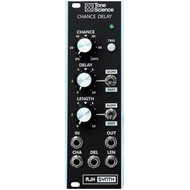Tone Science Triple Cross - AJH Synth
by Ellison Wolf
When this module came in for review there was a nice handwritten note from Allan Hall, proprietor of AJH Synths (if you haven’t guessed, those are Allan’s initials), wishing us well, among other niceties. When I wrote back (via email; shame on me, I know) thanking him for his thoughtful note and for sending the module he replied:
“It's a vintage-style module, so it's only right that it has an old-school hand-written analogue note with it:).”
While the AJH Synths Tone Science Triple Cross Xfader and Panner (AJHSTSTCXaP!) might be a “vintage-style module,” it’s undeniable that its many uses are timeless. The first module in a planned series of collaborations between AJH synths and UK synthesist/musician/composer/DiN Records label boss Ian Boddy, the idea for the module came about due to a patch Boddy had created on his vintage Serge modular for his 2016 album Tone Science, (also the name of a sub-label he runs) for a slowly morphing panning mix; a shapeshifting ambient chordal generative drone that needed three separate crossfader modules and a plethora of patch cables to realize. Somewhere down the road the idea for one module to take care of the bulk of this duty was born, and the AJH/Ian Boddy team created, with the end result being a module that does perhaps more than Boddy or Hall imagined at the outset of the design process.
The Triple Cross consists of three channels, each with the capability to be used collectively or independently as either a VCA, crossfader, panner, as a crossfader with a reverse panning function, or even for three channels of basic attenuation. In and of itself, this would make it a very useful utility module, but it’s when you start mixing the functionality of the three channels, or “misusing” it in some way, like feeding the VCA an audio rate signal for ring modulation, that it becomes much more interesting.
Each of the three channels consist of a Fade control and CV input with CV Level attenuverter, two inputs (A and B) and two numbered outputs (L-#, R-#). The CV controls are attenuverters with a center-point zero, which means that you can patch in a directionally-shaped envelope or LFO (basically just not a square, sine, or triangle wave) into the CV In for VCA use and depending on the output (L or R) and the knob position, get an ascending or descending envelope. This can create some cool effects, like when multing an envelope and running instances into each of the CV input for two tracks—one attenuated, and one attenuverted—so that there’s a bit of a lag between the two channels as one will be opening as the other is closing, to create some delay, a stuttering effect, or a hacked rhythm, among many other uses.
There is some normalization occurring here, to where the outputs from the first two channels are normalled to the inputs of Channel 3, (which has an input level control for both L and R), so you could also see use for this as a crossfading VCA-controlled four-channel mono or stereo mixer. Try saying that fast fifty times! For audio sources as the inputs, Triple Cross is really useful as a CVable panner/mixer—how Boddy first envisioned it—and patching the first two channels all up with audio rate signals (so they’re normalled to the Channel 3’s output) in every jack (CV included), and a chaotic and gnarly output was had. After clearing my head of this I started to understand Boddy’s desire for slowly morphing change, so using two different barely moving LFOs for the CV ins on both channels and patching up in this way got me closer to what I believe was the initial vision, and made for an interesting listen. Throw those inputs through some modulated filters beforehand and you’ll never hear the same thing twice.
Triple Cross is DC coupled, so it excels in creative CV mixing/combing use, and with two different (and random) CV inputs for each of the first two channels and patched into the SSF Entity Ultra-Perc (see review this issue) to control Length and V/Oct on the Ultra-Perc, it created excellent morphing CV, and being able to control the amount of the modulation at the output of the Triple Cross before it reached the Ultra-Perc was a nice bonus.
Vintage, old school…however you want to say it, the usefulness of Triple Cross and modules like it will never go out of style, and while he’s known for his music and composition, perhaps one day Ian Boddy will be equally known for being the inspiration behind the Triple Cross.
14 HP +12v 80mA -12v 72mA
Price: GBP 216.67


